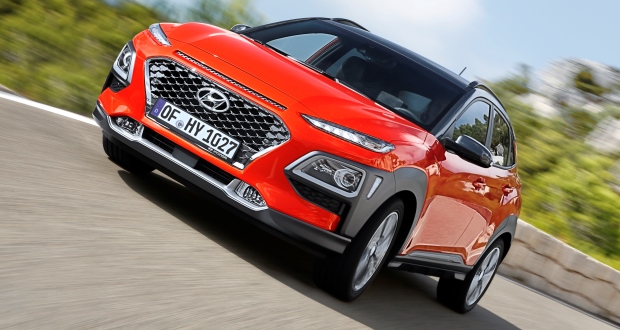Review Overview
Hyundai finally joins the small-SUV sector with the all-new Kona
 Another month and another new supermini-sized SUV enters the market. What can Hyundai’s Kona add?
Another month and another new supermini-sized SUV enters the market. What can Hyundai’s Kona add?
When the small B-segment SUV sector is set to double by 2020 to reach 2.2m units across Europe, it’s logical for any carmaker to get involved. Hyundai is incredibly late to the party – by conservative estimates there are another 18 or so already launched and/or on sale – but Hyundai’s UK president and CEO Tony Whitehorn reckons the brand’s Kona will still find up to 12,000 buyers in its first year, most of them from the retail sector.
The bold and brash exterior styling is somewhat of a departure from the brand’s usual conservative but coherent design language, but Whitehorn is defiant and confident of its appeal.
“We’ve been seen as a little bit of a ‘vanilla’, reliable brand so far, but the sporty N models are adding dynamism, the Ioniq range innovation and now the Kona with style. It’s also the first time we’ve put the model before the brand in our marketing; ‘Kona by Hyundai’. It’s about an attitude.”
The car has been launched in petrol guise with a 120bhp 1.0 2WD 6-speed manual from £16,195 (52.3-54.3mpg and 117-125g/km CO2, depending on wheel size) or a £24,995, top-spec Premium GT trim-only 177hp 1.6 4WD with 7-speed DCT auto (42.2mpg and 153g/km). The 1.0 2WD is expected to be by far and away the best-seller though and comes in S, SE, Premium and Premium SE trim options.
Diesel will follow next year with a choice of a 115bhp and 136bhp 1.6-litre engine. By mid-2018 there will also be a full EV with a useful 242 miles of range according to the NEDC cycle.
Standard safety kit for the UK model is laudable, including driver attention alert, lane keep assist, hill start assist and downhill brake control. But arguably the most useful new safety item of all – well-proven autonomous emergency braking (AEB) – is only standard on the 1.6 Premium GT. For the 1.0 versions, in any trim, it’s a £235 option. That should be rectified.
Back to the positives, previously big-car features like a head-up display appear from Premium SE upwards and Apple CarPlay and Android Auto are standard from mid-range SE. From a customer point of view, and eventual dealer buy-back perspective, Hyundai’s Whitehorn said predicted residual values are still excellent for such small SUVs, citing a 47-48% RV after three years for the newest in this segment (including the Hyundai Kona as well as such cars as the Seat Arona and Kia Stonic).
Ultimately, the new model as it stands at launch, lacks a compelling unique selling point though. Indeed, the only discernible ‘first’ Hyundai points to in its press material is a seatbelt that matches the exterior body colour for goodness sake – hardly a reason to choose it above the many others already in the market.
However, next year’s full EV version could really change all that and catapult the Kona to ‘must-have’ from merely ‘me-too’.
Behind the wheel
Just the two petrols were available at launch. The 177bhp 1.6 4WD is decent enough, although it doesn’t appear to be as fast as its official 7.9-second 0-62mph suggests and can be a bit raucous when revved hard.
 A driving mode button offers Sport, Eco and Comfort modes but it’s still not exciting to drive. Better value, more entertaining and by far the expected best-seller for now, will be the three-cylinder 120hp 1.0 petrol. Weighing up to 263kg less than its 1.6 4×4 sibling, it feels nippy, behaves well through corners and handles bumpy, stone-riddled tracks with ease, despite its lack of four-wheel drive.
A driving mode button offers Sport, Eco and Comfort modes but it’s still not exciting to drive. Better value, more entertaining and by far the expected best-seller for now, will be the three-cylinder 120hp 1.0 petrol. Weighing up to 263kg less than its 1.6 4×4 sibling, it feels nippy, behaves well through corners and handles bumpy, stone-riddled tracks with ease, despite its lack of four-wheel drive.
Upfront space is fine, but a little compromised in the rear. Six foot-plus passengers will struggle for knee room and the ‘seats-up’ 334-litre boot space is small for its class. Overall the Kona is fine, but the range feels a little ‘me-too’ until the full EV arrives to potentially change the supermini SUV game from mid-2018.
Models: 120bhp 1.0 2WD & 177bhp 1.6 4WD petrols; 115bhp 1.6 2WD & 136bhp 1.6 2WD & AWD diesels and 242-mile full EV
Prices: £16,195-£24,995
On sale: Now
Sales forecast: 12,000 pa (70% retail)
Rivals: Nissan Juke, Renault Captur, Citroen C3 Aircross
 Motor Trader The award-winning and longest running UK magazine for car retailing professionals. Your first stop for News, Jobs and Reports for the motor industry.
Motor Trader The award-winning and longest running UK magazine for car retailing professionals. Your first stop for News, Jobs and Reports for the motor industry.
